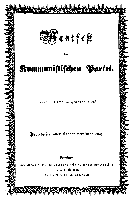

Editor's Introduction to the Manifesto (1976)
The Manifesto of the Communist Party was written
by Marx and Engels as the Communist League's programme on the
instruction of its Second Congress (London, November 29-December 8,
1847), which signified a victory for the followers of the new
proletarian doctrine who had upheld its principles during the
discussion of the programme questions.
When Congress was still in preparation, Marx and Engels
arrived at the conclusion that the final programme document should be
in the form of a Party manifesto (see Engels' letter to Marx of
November 23-24, 1847). The catechism form usual for the secret
societies of the time and retained in the "Draft of a Communist
Confession of Faith" and Principles of Communism (see this
volume, pp. 96-103 and 341-57), was not suitable for a full and
substantial exposition of the new revolutionary world outook, for a
comprehensive formulation of the proletarian movement's aims and
tasks.
Marx and Engels began working together on the
Manifesto while they were still in London immediately after
the congress, and continued until about December 13 when Marx returned
to Brussels; they resumed their work four days later (December 17)
when Engels arrived there. After Engels' departure for Paris at the
end of December and up to his return on January 31, Marx worked on the
Manifesto alone.
Hurried by the Central Authority of the Communist
League which provided him with certain documents (e.g., addresses of
the People's Chamber (Halle) of the League of the Just of
Novemher 1846 and February 1847, and, apparently, documents of the
First Congress of the Communist League pertaining to the discussion of
the Party programme), Marx worked intensively on the
Manifesto through almost the whole of January 1848. At the
end of January the manuscript was sent on to London to be printed in
the German Workers' Educational Society's printshop owned by a German
emigrant J. E. Burghard, a member of the Communist League.
The manuscript of the Manifesto has not
survived. The only extant materials written in Marx's hand are a draft
plan for Section III, showing his efforts to improve the structure of
the Manifesto, and a page of a rough copy (both are published
in this volume in the section "From the Preparatory Materials",
pp. 576 and 577-78).
The Manifesto came off the press at the end of
February 1848. On February 29, the Educational Society decided to
cover all the printing expenses.
The first edition of the Manifesto was a
23-page pamphlet in a dark green cover. In April-May 1848 another
edition was put out. The text took up 30 pages, some misprints of the
first edition were corrected, and the punctuation improved.
Subsequently this text was used by Marx and Engels as a basis for
later authorised editions. Between March and July 1848 the
Manifesto was printed in the Deutsche Londoner
Zeitung, a democratic newspaper of the German emigrants. Already
that same year numerous efforts were made to publish the
Manifesto in other European languages. A Danish, a Polish (in
Paris) and a Swedish (under a different title: "The Voice of
Communism. Declaration of the Communist Party") editions appeared in
l848. The translations into French, Italian and Spanish made at that
time remained unpublished. in April I848, Engels, then in Barmen, was
translating the Manifesto into English, but he managed to
translate only half of it, and the first English translation, made by
Helen Macfarlane, was not published until two years later, between
June and November 1850, in the Chartist journal The Red
Republican. Its editor, Julian Harney, named the authors for the
first time in the introduction to this publication. All earlier and
many subsequent editions of the Manifesto were anonymous.
The growing emancipation struggle of tlte proletariat
in the 60s and 70s of the last century led to new editions of the
Manifesto. The year 1872 saw a new German edition with minor
corrections and a preface by Marx and Engels where they drew some
conclusions from the experience of the Paris Commune of 1871. This and
subsequent German editions (1883 and 1890) were entitled the
Communist Manifesto. In 1872 the Manifesto was
first published in America in Woodhull & Claflin's Weekly.
The first Russian edition of the Manifesto,
translated by Mikhail Bakunin with some distortions, appeared in
Geneva in 1869. The faults of this edition were removed in the 1882
edition (translation by Georgi Plekhanov), for which Marx and
Engels, who attributed great significance to the dissemination of
Marxism in Russia, had written a special preface.
After Marx's death, the Manifesto ran into
several editions. Engels read through them all, wrote prefaces for the
1883 German edition and for the 1888 English edition in Samuel Moore's
translation, which he also edited and supplied with notes. This
edition served as a basis for many subsequent editions of the
Manifesto in English--in Britain, the United States and the
USSR. In 1890, Engels prepared a further German edition, wrote a new
preface to it, and added a number of notes. In 1885, the newspaper
Le Socialiste published the French translation of the
Manifesto made by Marx's daughter Laura Lafargue and read by
Engels. He also wrote prefaces to the 1892 Polish and l893 Italian
editions.
The 1888 English edition is taken as the basis for the
present publication. All the differences in reading between this and
the German editions and also Engels' notes to it and to the 1890
German edition are given in footnotes.

|